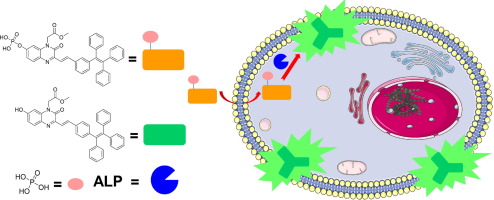当前位置:
X-MOL 学术
›
Bioorg. Med. Chem.
›
论文详情
Our official English website, www.x-mol.net, welcomes your
feedback! (Note: you will need to create a separate account there.)
In situ localization of alkaline phosphatase activity in tumor cells by an aggregation-induced emission fluorophore-based probes.
Bioorganic & Medicinal Chemistry ( IF 3.3 ) Pub Date : 2019-12-19 , DOI: 10.1016/j.bmc.2019.115284 Qinghua Guan 1 , Xinmiao Lu 1 , Yue Su 2 , Jichen Xu 3 , Xiaofei Liang 3 , Peiyong Li 4 , Xinyuan Zhu 2
Bioorganic & Medicinal Chemistry ( IF 3.3 ) Pub Date : 2019-12-19 , DOI: 10.1016/j.bmc.2019.115284 Qinghua Guan 1 , Xinmiao Lu 1 , Yue Su 2 , Jichen Xu 3 , Xiaofei Liang 3 , Peiyong Li 4 , Xinyuan Zhu 2
Affiliation

|
In situ detection of certain specific enzyme activities in cells is deeply attached to tumor diagnosis. Conventional enzyme-responsive fluorescent probes have difficulty detecting targeted enzymes in situ in cells due to the low detection accuracy caused by the spread of fluorescence probes. In order to solve this problem, we have designed and synthesized an enzyme-responsive, water-soluble fluorescent probe with AIE characteristics, which could aggregate and precipitate to produce in situ fluorescence when reacting with the targeted enzyme in cells. The AIE fluorophore (TPEQH) was utilized to design the enzyme-responsive, fluorescent probe (TPEQHA) by introducing a phosphate group on to it, which could be specifically decomposed by the targeted enzyme, namely alkaline phosphatase (ALP). In tumor cells, TPEQH was highly produced due to the interaction of phosphate on the TPEQHA and the overexpressed ALP. Water-insoluble TPEQH then precipitated and release fluorescence in situ, thereby successfully detecting the ALP. Furthermore, the expression level of ALP could be determined by the fluorescence intensity of TPEQH with higher accuracy due to the inhibition of TPEQH leak, which demonstrated a potential application of in suit ALP detection in both clinical diagnosis and scientific research of tumor.
中文翻译:

聚集诱导的发射荧光团为基础的探针在肿瘤细胞中原位定位碱性磷酸酶的活性。
细胞中某些特定酶活性的原位检测与肿瘤诊断密切相关。由于由荧光探针的扩散引起的低检测精度,常规的酶反应性荧光探针难以在细胞中原位检测目标酶。为了解决这个问题,我们设计并合成了具有AIE特性的酶响应型水溶性荧光探针,当与目标酶在细胞中反应时,该探针可以聚集并沉淀以产生原位荧光。AIE荧光团(TPEQH)用于通过在其上引入磷酸基团来设计酶促反应性荧光探针(TPEQHA),该磷酸基团可以被目标酶即碱性磷酸酶(ALP)特异性分解。在肿瘤细胞中 由于磷酸在TPEQHA和过表达的ALP上的相互作用,TPEQH的产量很高。然后,水不溶性TPEQH沉淀并原位释放荧光,从而成功检测出ALP。此外,由于TPEQH泄漏的抑制作用,可以通过TPEQH的荧光强度来更准确地确定ALP的表达水平,这证明了ALP检测在肿瘤的临床诊断和科学研究中的潜在应用。
更新日期:2019-12-20
中文翻译:

聚集诱导的发射荧光团为基础的探针在肿瘤细胞中原位定位碱性磷酸酶的活性。
细胞中某些特定酶活性的原位检测与肿瘤诊断密切相关。由于由荧光探针的扩散引起的低检测精度,常规的酶反应性荧光探针难以在细胞中原位检测目标酶。为了解决这个问题,我们设计并合成了具有AIE特性的酶响应型水溶性荧光探针,当与目标酶在细胞中反应时,该探针可以聚集并沉淀以产生原位荧光。AIE荧光团(TPEQH)用于通过在其上引入磷酸基团来设计酶促反应性荧光探针(TPEQHA),该磷酸基团可以被目标酶即碱性磷酸酶(ALP)特异性分解。在肿瘤细胞中 由于磷酸在TPEQHA和过表达的ALP上的相互作用,TPEQH的产量很高。然后,水不溶性TPEQH沉淀并原位释放荧光,从而成功检测出ALP。此外,由于TPEQH泄漏的抑制作用,可以通过TPEQH的荧光强度来更准确地确定ALP的表达水平,这证明了ALP检测在肿瘤的临床诊断和科学研究中的潜在应用。











































 京公网安备 11010802027423号
京公网安备 11010802027423号